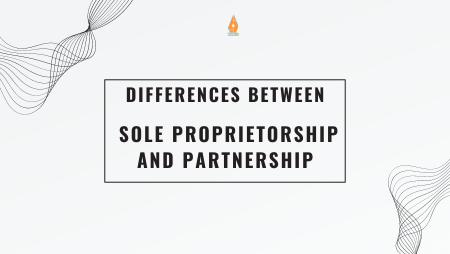As the business environment is constantly changing, it is essential to understand the various forms of business. As assignment helpers, we always come across students seeking clarification on these concepts in their commerce and business classes. In this blog, students will learn the basic concepts of sole proprietorship and partnership business structures that will make it easy for them to understand the difference between the two.
1. What is Sole Proprietorship?
Definition and Characteristics
A sole proprietorship is a legal business that is easy to establish and the most preferred among various business entities. It is a sole Proprietorship business, which means that the person who started it manages all of it. This comprises the company’s management, decision-making, and all other responsibilities regarding risk and responsibility.

Advantages of Sole Proprietorship
Simplicity and Ease of Setup: They can easily be founded without much adherence to legal formalities as single individuals own most.
Full Control: One significant advantage is that all decisions are made by the owner himself, which excludes time-consuming interlocutors and allows for the prompt implementation of measures.
Profit Retention: Whatever income or profit the business earns is exclusively the owner’s property.
Disadvantages of Sole Proprietorship
Unlimited Liability: The owner must bear all the failures and costs associated with the business venture, including personal property.
Limited Resources: Sole traders might face difficulties mobilizing funds, organizing and obtaining necessary resources, and financing.
Loneliness in Decision-Making: The owner must do all of the decision-making processes, which could prove to be very daunting.
What is a Partnership?
Definition and Characteristics
The partnership is a company structure in which two or more parties own the company and share different responsibilities for managing the business. It refers to the relationship between partners who mutually operate the business, split revenues, and participate in managerial decisions.

Types of Partnerships
General Partnership: In a general partnership, all partners are liable to each other and to the partnership, and all partners are entitled to equal shares of the profits.
Limited Partnership: Geared and combines general and limited partners, where the latter have limited risks and control over the firm’s operations.
Advantages of Partnership
Shared Responsibilities: For instance, partners may divide workflow and allocate tasks that one employee was adequately suited for in their previous job.
Increased Resources: Another key difference between the two types of businesses is that partnerships usually have more capital than sole trader businesses.
Collaborative Decision-Making: Partners can ask each other, which tends to result in balanced judgment calls.
Disadvantages of Partnership
Shared Profits: Revenue items must be split between partners, thus slicing down the payout for every individual.
Potential for Disputes: There will always be disputes and disagreements about ideas, and they could impact business activities.
Unlimited Liability: With general partnerships, the liability of all partners is unlimited, meaning they are personally responsible for business debts and all other liabilities.
Critical Differences Between Sole Proprietorship and Partnership-With Assignment helpers
Ownership and Control
A sole proprietorship is a business entity owned and managed by a single individual who controls the business. On the other hand, partnership means joint control and ownership of business by two or more people. This distinction affects who makes decisions and who is assigned specific tasks.
Liability
A significant distinction between the two structures relates to liability. Manager liability is unlimited because it is a sole proprietorship, meaning owners’ assets could be used to pay for business debts. As with general partnerships, partners in limited partnerships have unlimited liability, but limited partners are somewhat shielded from liability.
Resources and Capital
There is usually better access to resources and capital since this is an offering from several partners. One of the main concerns for sole traders is the process of financing and obtaining other resources on their own.
Profit Distribution
This form of business organization means that all the profits accruing from the business are the owner’s sole property. In a partnership, profits are split among the partners concerning the provisions of the partnership deed.
Decision-Making
Sole traders usually make quick decisions since the owner has the final say on all decisions. Potential advantages: Decisions are made based on consensus, which could be helpful for different opinions, or it can be disadvantageous because of possible conflicts.
Assignment Helpers and Business Structure example
Consider Your Goals and Resources
When choosing between a sole trader and a partnership, some factors you should consider include the following: If assignment homework businesses are the nature of the business where cooperation and multiple skills are beneficial, a partnership can indeed have a huge edge.
Evaluate Liability and Risk
Consider your risk tolerance level and willingness to accept personal responsibility and exposure. If you are interested in limited liability, a limited partnership might be the right choice for you. However, if you are ready to assume the risks and need total freedom, going for sole trader is plausible. Assignment helpers can guide you in your commerce topics like these two topics.
Making an Informed Decision
Any commerce and business student must compare sole proprietorship with partnership. In this blog post, we, as assignment helpers, have endeavored to enlighten you on these business structures. Comparing the advantages and disadvantages, as well as identifying the key differences, can help you make relevant decisions that will meet your needs and expectations in terms of academic and professional achievements. Assignment helpers are the light you need for your exams and coursework. Contact now.


